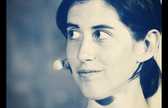

European Bank Nightmare Far From Over as Fines and Fintech Loom. If you had to pick the moment when European banking reached the point of no return, which would you choose?
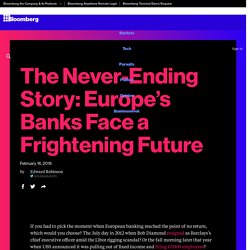
The July day in 2012 when Bob Diamond resigned as Barclays’s chief executive officer amid the Libor rigging scandal? Or the fall morning later that year when UBS announced it was pulling out of fixed income and firing 10,000 employees? How about Sept. 12, 2010, when Basel III’s raft of costly capital requirements started upending the economics of global finance? All signature events, to be sure. But try May 21, 2015. What Low Oil Prices Really Mean. Since the start of 2016, oil prices have swung between $27 and $42 per barrel, about a quarter of the 2008 peak crude oil price of $145.

On February 16, oil ministers from Saudi Arabia, Russia, Qatar, and Venezuela agreed to a tentative deal to freeze their production in an attempt to boost prices. This was a characteristic move. For decades, this is how the oil business has worked. Producers carefully control production to try to match supply to demand. But there’s a lag between these decisions and their effects, creating the boom and bust cycles so typical in the business. Un pugno di articoli bellissimi. Dieci libri sulla comunicazione politica che non puoi perdere. The transformative potential of gardening with data. The following guest post is by Farida Vis from the Everyday Growing Cultures research project.

The project looks at the potentially transformative effect of bringing together the food growing and open data communities. Those supporting the government’s open data agenda highlight the business case for open data, an economic argument about its moneysaving potential, along with the suggestion that it will lead to better-informed citizens. Five Borough Farm. Garden Maps: Home. “Information: A Very Short Introduction” (Essential Readings in the Philosophy of LIS) In a recent tweet, Professor David Lankes asked a seemingly easy question: And he got quite a few responses: There are quite a few more responses, but you get the drift: librarians don’t have a common definition of information in practice.

Which is weird, given the primacy of information in librarianship. What was happening during the massacres? Jean-Christophe Bailly, vers une utopia povera ? Real-Time Politics. Real-Time Politics: The Internet and the Political Process Philip E.

Agre Department of Information Studies University of California, Los Angeles Los Angeles, California 90095-1520 USA. ZONES. La série brosse en particulier un tableau saisissant de la condition des femmes.
Gender. Mapping the world with Tweets. A new paper on the peer-reviewed online journal First Monday summarizes the results of a project to use geographic data gathered from Tweets to create a picture of the world according to Twitter.

The researches, led by GDELT co-creator Kalev Leetaru, used the Twitter decahose, a massive feed of 10 percent of all tweets, access to which is normally sold at high price to marketers. The project covers the period of the Oct. 23, 2102, to November 30, 2012. During this time, 1,535,929,521 tweets were streamed from 71,273,997 unique users -- about 2.8 terabytes worth of data. But only about 3.04 percent of those contained geolocation data -- either exact coordinates from mobile phones or user-selected locations. All the same, that's an awful lot of geographical information, and allowed the authors to create this map of a month in the life of Twitter (Bigger, high-resolution version here): This map (full size), shows the tweets color-coded by the language they're written in.
Le monde expliqué en 100 personnes. Une visualisation des principaux indicateurs de développement et données démographiques.
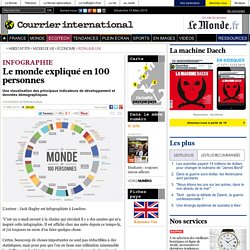
Twistori. We Feel Fine / by Jonathan Harris and Sep Kamvar. The new cool : les hacking musicaux. De la régularité d’un battement de cœur, des vagues langoureuses, du battement lascif d’une rangée de cil, de la mastication frémissante d’une bouche avide aux gouttes de pluie sur de la tôle froissée au chant d’un oiseau amoureux, aux roulis des feuilles printanières dans le vent, les bruissements du monde si joliment nommés par Michel Serre font partie d’un écosystème sonore qui conditionne la musicalité telle que nous la vivons aujourd’hui.

L’expérimentation contemporaine se tisse d’un beau besoin de se loger dans les hypothétiques déserts musicaux d’une nature brûlante et mobile. La musique électronique réinvestit les sonorités du monde en choquant les schémas de rythmes « naturels » et réorganise l’ordre d’une parodie plus que satisfaisante. Gestionnaire de compte inactif pour les personnes de confiance - Centre d'aide Comptes Google. Le gestionnaire de compte inactif permet aux utilisateurs de partager une partie des données de leur compte ou de prévenir un contact si leur compte est inactif depuis un certain temps.
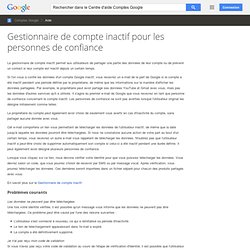
Google Street View Hyperlapse. Hatebase. Top 17 des clips en version « shred », ou le playback sans bande son. Prenez un clip (ou un live), coupez le son, et ré-enregistrez la musique en fonction de ce que vous voyez.
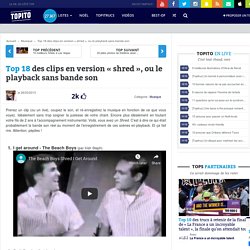
Art installation gives flies the power of Twitter. Laughtivism. Cogito algo sum. La documentation du monde que permet et autorise le numérique, sa "redocumentarisation" plus précisément, pose en permanence la question de la mémoire. Parmi une infinité d'autres, en voici 3 exemples qui me semblent significatifs et permettent de poser la question de l'externalisation de nos mémoires (personnelles, sociales, etc.) sous un angle un peu différent. Le voyage dans le temps proposé par Google Earth. What Do We Mean By Small Data. Earlier this week we published the first in a series of posts on small data: “Forget Big Data, Small Data is the Real Revolution”. In this second in the series, we discuss small data in more detail providing a rough definition and drawing parallels with the history of computers and software. What do we mean by “small data”? Let’s define it crudely as: “Small data is the amount of data you can conveniently store and process on a single machine, and in particular, a high-end laptop or server”
Estonia’s plan to get 6 year olds coding is a stroke of genius. Teaching people to code is the new hotness: startups like Codecademy and Bloc are all about helping people learn to program quickly and easily online, and they have helped spawn a cultural movement lauded by the likes of Tim O’Reilly and Douglas Rushkoff. Some people are taking the idea a little further however. Just look at Estonia, the tiny Eastern European nation (population 1.3 million), where a new project is being put in place with the ambition of getting every six year old to learn coding at school. The “ProgeTiiger” scheme, according to reports, will begin pilots this year with the ambition of getting school kids of all ages to start coding.
There’s no suggestion yet that the classes will be mandatory, but the organization behind the move the Tiger Leap Foundation, says it wants to produce more creative computer users. Programming at Schools and Hobby Clubs. Modern computer and information technology studies at schools should not only focus on computers and word processing programmes. More and more technology has emerged in students’ lives, and to understand the principles of it they need to know more about programming and technology in general. The Tiger Leap Foundation has launched a programme called ProgeTiger which teaches programming, web applications and website creation during classes or in hobby clubs to students from grades 1 to 12. The aims of ProgeTiger are to: develop students’ logical thinking, creativity, mathematical skills etc.; demonstrate that programming can be interesting and done by anyone; teach the basics of programming through practical activity; and teach students to use different age-appropriate programming languages.
A la recherche de ma mémoire vive. Un accident cérébral grave suivi d’une amnésie… Ce journaliste de Forbes India raconte comment il a pu peu à peu reconstituer sa mémoire à partir de ses propres traces informatiques. Et transformer son existence en une accumulation de données quantifiées. Un double numérique, en somme. Jouez pour faire avancer la science!
Lâchez-donc Robot Unicorn Attack et venez aider la science! C’est en somme ce que conseille le site io9.com avec sa sélection de 8 jeux méga-cool pour aider les chercheurs. Content curation e giornalismo: perché agli editori conviene avere cura del proprio archivio. How tiny Estonia stepped out of USSR's shadow to become an internet titan. In 1995, four years after Estonia broke free from the USSR, Toomas Hendrik Ilves read a "very Luddite" book by Jeremy Rifkin called The End of Work. List of educational programming languages. An educational programming language is a programming language that is designed primarily as a learning instrument and not so much as a tool for writing programs for real-world work. Learning paths[edit] Many educational programming languages position themselves inside a learning path, that is a sequence of languages each designed to build on the others moving a student from easy to understand and entertaining environments to full professional environments.
Some of the better known are presented below. Assembly language[edit] Originally, machine code was the first and only way to program computers. Scratch (programming language) Scratch is a free desktop and online multimedia authoring tool that can be used by students, scholars, teachers, and parents to easily create games and provide a stepping stone to the more advanced world of computer programming or even be used for a range of educational and entertainment constructivist purposes from math and science projects, including simulations and visualizations of experiments, recording lectures with animated presentations, to social sciences animated stories, and interactive art and music. Viewing the existing projects available on the Scratch website, or modifying and testing any modification without saving it requires no online registration. Scratch 2 is currently available online and as an application for Windows, Mac OS X and Linux.[1][2] The source code of Scratch 1.x is made available under GPLv2 license and Scratch Source Code License.[3] The Scratch programming language is also used in the game creation tool Stencyl.
Mettiamocela via - Mafe de Baggis. Del perché l’alfabeto è diverso da Internet - Mafe de Baggis. Posted on | May 31, 2012 | 7 Comments. L'éducation à l'ère du numérique. Cette semaine, le Vinvinteur se penche sur la très vaste question de l’éducation à l’ère du numérique. Le numérique, un outil au service de la culture ou un simple gadget technologique ? Uno per uno, tutti per tutti. Il potere di organizzare senza organizzare: Amazon.it: Clay Shirky, F. Fasce. Sensori [in]coscienti - Discorsivo > Magazine.